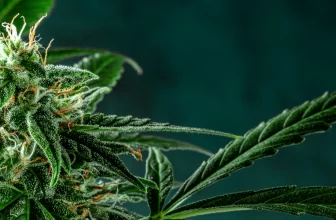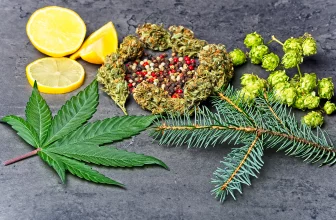
The difference between Marijuana and Synthetic Marijuana is extreme. So extreme we’ll begin this important article with a short play.
You’re out on the town and are craving a salad. You walk into a small deli and approach the person at the counter:
YOU: Could I get a salad?
PERSON: Ha! Salad! You should try our synthetic salad.
YOU: That sounds awful.
PERSON: No, it’s like the salad you know and love! It’s just created in a lab somewhere overseas with almost no oversight, using manmade chemicals and absolutely nothing resembling real salad.
[Person brings up a plate of bright green slime and sets it on countertop.]
YOU: Oh, dear. [gagging] I can’t even look at it.
PERSON: [begins sweating] No, you don’t understand! I just ate some myself! Yum!
YOU: Are you okay? You’re sweating profusely, and your eyes are jittery.
[Person suddenly points in terror over your shoulder.]
YOU: [looking around the empty store] I’m going to call an ambulance.
[Curtains close.]
If you felt that eating synthetic lab salad sounded like a bad idea at any point during this play, then chances are you’re not going to love synthetic marijuana.
What Is Marijuana?
Let’s first cleanse our pallets with marijuana.
Marijuana is a type of cannabis plant. Unlike industrial hemp (also a form of cannabis), marijuana is known for its high concentration of tetrahydrocannabinol, or THC. This cannabinoid is part of the plant’s output of organic compounds, which is concentrated in its sticky, resinous flowers.
The buds of the marijuana plant contain more than just THC, though. They also contain a broad spectrum of different cannabinoids and terpenes, which give the plant its distinctive aroma and have health benefits of their own.
It’s almost like we evolved with the plant — humans are naturally in sync to receive cannabinoids, as an endocannabinoid system comes stock with our bodies. Marijuana has been grown and enjoyed for thousands of years, with ancient cultures cultivating and smoking it as part of rituals, ceremonies, medicine, and casual enjoyment.
Marijuana offers more than just a good time. It also has real, verified medical benefits that make it a secret weapon in bringing relief to cancer patients. Though it’s still illegal at the federal level, two FDA-approved drugs contain THC. These are used to stimulate the appetite and treat nausea induced by undergoing chemotherapy. It has a host of other health benefits as well, offering potential treatment for the following conditions:
- arthritis
- endometriosis
- fibromyalgia
- migraine
- Parkinson’s disease
- epilepsy
- Tourette syndrome
- multiple sclerosis
- post-traumatic stress disorder (PTSD)
- anxiety
- Crohn’s disease
- rheumatoid arthritis
- irritable bowel syndrome
- insomnia
Though it was legal for most of human history, marijuana (and its straight-laced cousin hemp) was outlawed in the late 1930s as part of a misinformation campaign funded by corporations with financial incentives to see it gone. It has only recently begun to make a comeback.
As an intoxicant goes, marijuana is safe when used responsibly. According to the CDC, no one has ever died of a marijuana overdose, and its side effects are generally mild and transient.
What Is Synthetic Marijuana?
Synthetic marijuana is the unholy hellspawn that came about when a scientifically created compound was hijacked and turned into a recreational drug.
In an attempt to imitate THC’s effects, which gives you the sensation of being high when you use marijuana, the creators of synthetic marijuana got their hands on a synthetic cannabinoid called JWH-18. Invented by John Huffman as part of a federal research grant in 2004, JWH-18 was created solely to explore its interaction with endocannabinoid receptors in lab animals’ brains. Today, people use it because they believe it’s more difficult to detect in drug tests.
For many years, it’s actually been possible to purchase synthetic marijuana in many places simply because regulation hadn’t had a chance to catch it. Using names like “Black Mamba,” “K2,” Sexy Monkey,” and the very common name “Spice,” its use quickly proliferated in the late aughts.
Paying no attention to the “Not for human consumption” label on the package, people then smoke the substance and experience a particularly strong high that’s quite different from the one provided by marijuana. They may also enjoy seizures, convulsions, hallucinations, vomiting, and death as part of the experience.
No, seriously. It’s killing people. Because it’s often cut with legal ingredients, it’s been harder to control its spread.
Part of the problem is that there are hundreds of compounds out there that produce a high, and it’s hard to stay ahead of them legally when they’re continuously popping up like wildfires. Synthetic marijuana is largely created in overseas labs, where essentially no oversight is applied to making sure they are safe. Reporters trying to gain access to the labs have had an extremely difficult time doing so.
We do know that the pure chemicals created in these labs are then purchased in large bulk quantities, dissolved in acetone or similar solvent, and poured over some non-cannabis plant matter. After evaporating the acetone, what’s left are leaves saturated in manmade cannabinoids. Another way this is done is by spraying the cannabinoids onto dried leaves. Either way, the product is then sold for an enormous profit margin in corner stores, gas stations, and on the street.
Synthetic marijuana is nothing like marijuana; it is not mellow and it is extremely unhealthy. You’ll have no idea where it came from and what it’s laced with. For this reason, cannabis activists have taken issue with the name itself.
Take it from the man who invented them: “These things are dangerous — anybody who uses them is playing Russian roulette.”
Cannabis vs Synthetic Cannabis Summary
While marijuana is a totally natural substance that induces a generally mellow high, synthetic marijuana is a manmade chemical that’s leading to an increasing number of overdoses. It is made in largely unknown circumstances overseas where synthetic cannabinoids are sprayed or soaked into random plant matter.
The high produced by synthetic marijuana is far more powerful than that of actual marijuana. It can be anywhere from 1 to 800 times more potent, with many unknown compounds present to constantly stay ahead of the law.
The bottom line: it’s unpleasant, it’s dangerous, and it’s so much less fun than actual marijuana.
Our advice? If you want salad, eat salad.






